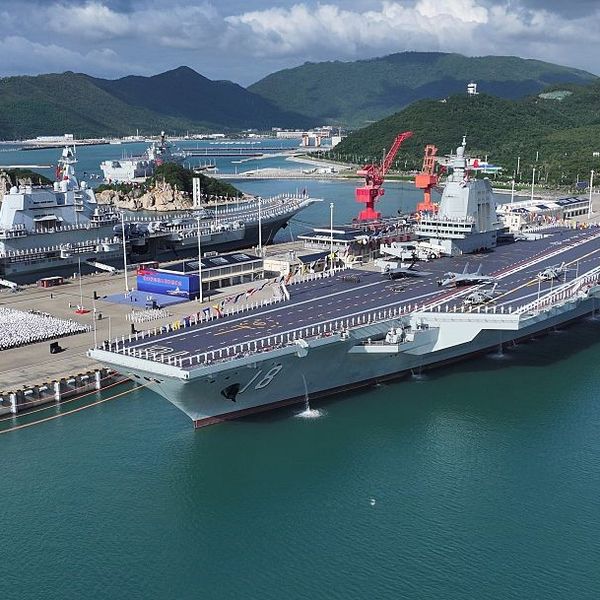OPINION — In early 2024, the American public received a stark warning from top U.S. security officials. Chinese state-sponsored hackers, known as "Volt Typhoon," had penetrated not just data repositories but embedded themselves deep within the control systems of U.S. critical infrastructure—including communication networks, energy grids, and water treatment facilities. As FBI Director Christopher Wray testified, the intent was a "pre-positioning of capabilities that can be turned on whenever they see fit" to "wreak havoc and cause real-world harm to American citizens and communities." This was not espionage in the traditional sense—it was operational preparation of the environment at a strategic scale.
No shots were fired, nor territory seized—yet this was an act of calculated, strategic hostility. Volt Typhoon is one battle in a much larger, undeclared conflict: the gray war the PRC is waging against the United States.
How did we get here? In the late 20th and early 21st centuries, the People’s Republic of China (PRC) began to formally articulate a new approach to conflict that diverged significantly from traditional warfare. This strategic evolution was first evident in 1999 with the publication of "Unrestricted Warfare" by two People's Liberation Army (PLA) colonels, Qiao Liang and Wang Xiangsui. This groundbreaking conceptualization expanded the battlefield beyond purely military engagements to encompass a vast array of domains, including economic, legal, and informational spheres.
Further solidifying this new paradigm, the PRC subsequently adopted the "Three Warfares" doctrine in 2003. This formalized framework specifically outlined three interconnected non-kinetic operations: psychological warfare, public opinion warfare, and legal warfare. Together, "Unrestricted Warfare" and the "Three Warfares" doctrine laid a profound intellectual and doctrinal foundation for China's strategy of confronting powers like the United States in ways that intentionally stopped short of direct military conflict. Despite their significant implications for global security and China's evolving approach to international relations, these paradigms largely escaped widespread public notice and critical scrutiny in the Western world at the time of their introduction. It’s hard to know precisely when China’s gray war began, but we can see the doctrinal basis for that war taking shape in 1999 and 2003.
Today, the gray zone can be described as the geopolitical space between peace and war where nations conduct activities to advance their national interests, attack and weaken their adversaries, and possibly set the conditions for a future war without triggering a military response. It is the domain of deniability, ambiguity, and incremental aggression. As scholar Hal Brands has argued, it is the preferred tool of revisionist powers seeking to challenge the existing order.
The PRC’s aggressive actions are not isolated, unconnected events to achieve tactical gains, but rather the gray zone is the central front in Beijing’s strategic competition with the United States. Its objective is not to defeat the United States on a conventional battlefield, but to orchestrate a strategic defeat by a thousand cuts—eroding American power, influence, and resilience, while reshaping the international order to suit Beijing’s ambitions, all without triggering a direct military response. Its ultimate aim is to achieve a victory so complete that by the time America recognizes the totality of its loss, the cost of reversing it will have become insurmountably high.
Defining Strategic Defeat in a Gray War
The concept of strategic defeat has historically been tied to the battlefield: the surrender of an army, the fall of a capital, the destruction of cities and infrastructure, the massive loss of life, the signing of a treaty on an adversary’s terms. In a gray war, the metrics of victory and defeat are fundamentally different. They are not measured in territory lost but in access and influence ceded, not in ships sunk but in alliances fractured and capabilities sidelined, not in casualties but in confidence shattered and decision autonomy undermined.
Strategic defeat in the context of a gray war can be defined as: The cumulative loss of relative power, autonomy, and global influence across cognitive, geopolitical, military, economic, and technological domains—resulting in a diminished ability to deter, resist, or effectively respond to an adversary’s actions and ambitions.
What does this mean in practical terms? For the United States, it would mean a future where the U.S. dollar is no longer the undisputed global reserve currency, weakening America’s ability to levy effective sanctions. It would mean a world where American security guarantees are no longer trusted by allies, forcing nations in the Indo-Pacific and Europe to accommodate Beijing’s demands.
For prospective partners, it would mean the path of least resistance is to align with a new center of gravity in Beijing. And for our global adversaries, it would signal that the era of American primacy is over, emboldening them to challenge the international norms the United States has long championed.
As the 2022 U.S. National Security Strategy states, the PRC is "the only competitor with both the intent to reshape the international order and, increasingly, the economic, diplomatic, military, and technological power to do it." Strategic defeat is the realization of that intent.
The Cipher Brief brings expert-level context to national and global security stories. It’s never been more important to understand what’s happening in the world. Upgrade your access to exclusive content by becoming a subscriber.
The Six Fronts of China's Gray War
Beijing has evolved its original “Three Warfares” doctrine and is now waging a coordinated gray war across six interconnected fronts. Success on each axis is not necessary; rather, incremental gains in one area generate vulnerabilities in another, creating a cascading strategic effect. The struggle is not confined to the military domain but extends to economics, technology, diplomacy, and cognition itself. If left uncontested, Beijing could erode U.S. alliances, undermine deterrence, and shape a strategic environment in which America’s choices are constrained before conflict ever begins.
Dominate the Cognitive Environment
China seeks to control the global narrative, portraying itself as a responsible rising power while casting the United States as a declining, chaotic hegemon. PLA doctrine explicitly identifies the cognitive domain as a new battlefield, where perception and belief are as contested as territory.
The State Department’s Global Engagement Center – which was disbanded earlier this year – documented Beijing’s tactics: seeding pro-PRC messaging through foreign media, deploying bot networks to inflame divisions in democratic societies, and spreading disinformation on issues ranging from COVID-19’s origins to the integrity of U.S. elections. Through its United Front system—a unique blend of influence and interference activities, as well as intelligence operations that the CCP uses to shape its political environment—Beijing targets individuals, social and political groups, academia, business leaders, military leaders, policy makers and U.S. allies with persuasive narratives, manipulated imagery, and coercive pressure. It is an assault on cognition. The objective is to isolate the United States from its allies and demoralize the American public, thereby undermining the national capability—and will—to compete. This is a war over knowledge, belief, and decision-making autonomy—one that could prove decisive.
Limit U.S. Military Deterrence Options
The PLA has spent three decades developing a formidable Anti-Access/Area Denial capability. As detailed in the Pentagon’s annual China Military Power Report, this network of long-range anti-ship missiles, integrated air defenses, and advanced naval platforms is designed to make it prohibitively dangerous for U.S. forces to operate in the seas and skies around China's periphery. The goal is to neutralize America’s primary strength—its power projection—and create a scenario, particularly over Taiwan, where Washington hesitates to intervene.
The PRC’s intent is that intimidation, threats, and stated redlines add cognitive strength to its military deterrence and its efforts to shape U.S. military decisions to its advantage. PLA’s “deterrence by demonstration”—which employs constant aggressive maneuvers in the Taiwan Strait, missile launches, and aggressive intercepts—is designed to increase psychological pressure and a sense of inevitability, erode resolve, intimidate, and coerce decisions favorable to China. The rapid expansion of China’s nuclear arsenal (DF-41 ICBMs, new silos) also broadens Beijing’s deterrence toolkit.
It is likely that the PRC will be more provocative if it believes the United States is unlikely to respond for fear of escalation. Furthermore, Beijing closely observes the Western response to Russia’s war in Ukraine, treating it as a live-fire case study of Western resolve and military-industrial capacity, calibrating its own gray war accordingly in what amounts to a strategic partnership with Moscow.
Erode and Displace U.S. Power, Altering Geopolitical Norms
Where the U.S. once led in building the post-war international order, China now works diligently to co-opt or supplant it. Through initiatives like the Belt and Road Initiative, the PRC has used its vast economic resources to create dependencies, gaining political leverage and, in cases like Sri Lanka's Hambantota Port, control of strategic assets, while also working to undermine American access and influence. As the U.S. signals an intent to withdraw investments and presence from some countries and regions, the PRC will seek to fill those vacuums.
The PRC's construction and weaponization of new islands to change international boundaries in the South China Sea are also part of its strategy to create new geopolitical realities that expand PRC presence and influence. Simultaneously, Beijing has successfully placed its officials in key leadership positions within United Nations bodies, influencing the setting of international standards on everything from technology to aviation in ways that favor its own authoritarian model. PRC influence in the International Telecommunication Union and efforts to set standards for 5G, AI governance, and internet “sovereignty”—all erode the liberal international order in an attempt to sideline American influence.
Weaken and Compromise Essential U.S. National Systems
The Volt Typhoon intrusions are the most visible element of a concerted campaign to hold American critical infrastructure at risk and “prepare the battlefield,” but there are others. According to media reports, the PRC has attempted to penetrate and compromise, with mixed results, U.S. energy, water, communications, transportation, and information infrastructure as well as government organizations. U.S. space infrastructure and emerging AI infrastructure, such as data centers, are also vulnerable.
The PRC’s state-sponsored hackers have also engaged in persistent, widespread economic espionage, targeting U.S. corporations, universities, and research labs to steal the intellectual property that forms the backbone of the American economy. Former FBI Director Wray has stated that the PRC’s hacking program is larger than that of every other major nation combined. This front of the gray war aims to weaken America from within, creating systemic brittleness and giving Beijing coercive leverage in a crisis.
Manipulate Economic Dependencies and Supply Chains
For decades, the West viewed economic interdependence with China as a force for liberalization. Beijing, however, saw it as a strategic vulnerability to be cultivated and exploited. The PRC has weaponized its dominant position in critical supply chains, as seen when it restricted exports of gallium and germanium in 2023 in response to U.S. semiconductor controls. Its control over the processing of some 90% of the world’s rare earth minerals gives it a chokehold over inputs essential to the U.S. defense and technology industries. This economic statecraft, documented in case studies by the Peterson Institute for International Economics, is used to punish and coerce other nations, demonstrating to the world the costs of defying Beijing.
Other dependencies are equally concerning. The United States remains reliant on China for pharmaceuticals and active pharmaceutical ingredients , batteries, and solar panel components—sectors where Beijing could impose sharp costs on adversaries. Through such statecraft, China demonstrates the penalties for defiance and signals that economic integration is a vulnerability, not a safeguard.
Gain Technological Superiority over the U.S.
The final and perhaps most crucial front is the race for technological supremacy. Through state-directed policies like "Made in China 2025" and its "Military-Civil Fusion" strategy, the PRC is mobilizing the full power of its state and society to dominate the foundational technologies of the 21st century: artificial intelligence, quantum computing, biotechnology, and next-generation telecommunications.
China already leads the world in patent filings for AI, fintech, and quantum encryption. Leadership in these fields, as argued in reports by the Special Competitive Studies Project (SCSP), will not only drive future economic growth but will also confer decisive military and intelligence advantages. China’s theft of U.S. intellectual property has directly accelerated its technological advancement in both commercial and military sectors, often allowing Chinese firms and state entities to leapfrog developmental obstacles and compete globally with U.S. companies. The PRC is not merely seeking to catch up; it is determined to leapfrog the United States at any cost and write the rules for the next technological era.
Need a daily dose of reality on national and global security issues? Subscriber to The Cipher Brief’s Nightcap newsletter, delivering expert insights on today’s events – right to your inbox. Sign up for free today.
American Vulnerabilities and Responses
China's gray war strategy is effective because it expertly exploits the inherent vulnerabilities of an open, democratic society. The openness of the U.S. economy and academic institutions, a traditional source of strength, creates avenues for technology theft and malign influence. America’s political polarization, amplified by social media, is a fertile ground for PRC information operations. A chaotic global information environment, which is at the fingertips of information-hungry Americans, further provides infrastructure, camouflage, and endless surrogates for China’s cognitive warfare efforts.
The United States is not idle. It has finally awakened to the challenge. The 2022 CHIPS and Science Act represents a historic investment to restore domestic semiconductor manufacturing. Stricter export controls, led by the Commerce Department, aim to slow China's progress in advanced computing. New and strengthened alliances, chief among them the AUKUS pact with Australia and the United Kingdom, are designed to bolster collective deterrence in the Indo-Pacific.
These responses, while necessary, remain largely fragmented and they are created within the context and the confines of the “rules-based global order” that the PRC often ignores. As many analysts at institutions like the Center for a New American Security have argued, the U.S. government is still largely structured for a bygone era. It lacks the integrated, whole-of-government machinery required to effectively counter a holistic, long-term gray zone competitor. We are waging a networked war with a hierarchical bureaucracy, responding to discrete crises rather than waging a proactive, continuous campaign. And the tools that we often choose to employ, such as relying solely on diplomacy and limited assistance to regional allies to dissuade Beijing from asserting its sovereignty in the South China Sea, are unsuccessful in inducing PRC compliance.
China’s Confidence and Risks
Beijing’s confidence in this strategy is rooted in its own strategic culture and its perception of American decline. The Chinese Communist Party’s (CCP) ideology, especially under Xi Jinping, is saturated with the narrative of an "East rising and West declining," a belief that history is on China's side. This modern confidence is layered atop an ancient strategic tradition, epitomized by Sun Tzu, that prizes victory without direct conflict (shangbing fa mou). A gray war is the ultimate expression of this philosophy: to win by outmaneuvering, outwitting, and demoralizing the opponent until their will to resist collapses.
Yet, this strategy is fraught with risk—for China. In his book The Long Game, Rush Doshi argues that Beijing’s aggressive turn has prematurely awakened a sleeping giant, galvanizing the very anti-China coalition it sought to avoid. Every coercive trade action, every act of cyber aggression, and every belligerent statement pushes the United States. and its allies closer together. The greatest risk of all is miscalculation. A gray zone action over Taiwan—such as a declaration of a "quarantine"—could easily be misinterpreted, spiraling into a devastating hot war that would shatter China’s economic ambitions and potentially threaten the CCP’s grip on power.
Disrupting China's Gray War and Imposing Costs
Recognizing that we are in a gray war is the first, foundational step. Winning it requires a fundamental shift in American strategy from reaction to proaction. As noted in a previous Cipher Brief article, the U.S. has to rethink, retool, and reorient so that it is as prepared for a gray war as it is for traditional conflict; that has yet to be achieved. Further, the U.S. must understand and manage risk in the gray zone. The gray zone is filled with real threats, many things that aren’t real, and outright deception.
Russia, China, and Iran flood the information environment with false and manipulated information; fabricated organizations and events; persuasive but false national narratives; and calculated threats and intimidation intended to weaken our resolve, impair our judgment, and push us toward decisions that favor their interests. Despite this gray zone “fog of war”, the U.S. and its allies must move beyond simply defending against China's gray zone aggressions and begin to actively disrupt them, impose meaningful costs, and shift from a defensive to an offensive posture. A strategy to do so must include four key lines of effort:
First, systematic exposure. The United States must win the battle for truth by systematically declassifying and publicly attributing PRC gray zone activities in near-real-time. By stripping away the cloak of deniability from actions like Volt Typhoon or covert influence operations, Washington can rally domestic and international opinion, making it harder for Beijing to operate. This exposure can also occur at very senior levels. China should not be able to engage in trade or diplomatic talks with the United States without answering for its systematic attacks on U.S. sovereignty, institutions, critical infrastructure, and global influence.
Second, impose proportional costs. For too long, China’s gray zone actions have been low-cost and low-risk. Washington. must change the PRC’s risk-gain calculation, which currently demonstrates that the PRC sees more gains than risks in its gray zone actions. U.S.leaders must speak clearly to the PRC and other adversaries on the costs of their gray zone attacks. The United States must lead a coalition to develop a menu of pre-planned, rapid-response options. If China uses economic coercion against an ally, the G7 should respond with coordinated relief funds and joint legal challenges. If a Chinese entity is caught stealing intellectual property, it should face crippling sanctions.
Third, build collective resilience—not just at the national level, but across society and allied networks. Strengthening resilience means ensuring U.S. intelligence collection and analysis is sharply focused on evolving gray zone threats. The United States should deepen security, intelligence, and crisis response cooperation with core allies through frameworks like AUKUS and the so-called “Quad alliance” (an informal security dialogue involving Australia, India, Japan, and the United States), while also investing in broader multi-level partnerships that include the private sector and academia. The U.S. and its allies should pioneer an "economic NATO" model, creating shared safety nets and coordinated defense packages so that an economic or cyberattack against one is met with rapid collective support from all members.
Domestically, resilience is important because PRC cyberattacks, threats to critical infrastructure, and efforts to sow dissent, undermine U.S. institutions, interfere with supply chains, and influence U.S. decision-making can impact all Americans. Resilience starts with informed leadership at all levels of government and timely information sharing so communities and businesses can trust public information and know how to respond.
Finally, target the architects. Sanctions and other punitive measures should not only target corporate entities but also the specific Chinese Communist Party officials and PLA officers who design and direct these gray zone campaigns. Making the conflict personal for the individuals involved raises the stakes and can deter future aggression.
The challenge posed by China’s gray war is formidable, but it is not insurmountable. The United States stands at a critical juncture: either we continue to respond in a disjointed manner, or we forge a unified, proactive strategy to counter Beijing's multifaceted aggression. This demands an immediate, integrated, whole-of-nation response across all domains—governmental, private sector, and civil society—to systematically expose and build collective resilience against Beijing’s coercive actions. And it requires U.S. decisionmakers to overcome their fear of escalation and finally impose real costs on Beijing for engaging in gray warfare against the U.S. Failure to act decisively now risks a strategic defeat by incremental erosion, fundamentally reshaping the international order and diminishing American influence for generations to come.
All statements of fact, opinion, or analysis expressed are those of the author and do not reflect the official positions or views of the U.S. Government. Nothing in the contents should be construed as asserting or implying U.S. Government authentication of information or endorsement of the author's views.
The Cipher Brief is committed to publishing a range of perspectives on national security issues submitted by deeply experienced national security professionals.
Opinions expressed are those of the author and do not represent the views or opinions of The Cipher Brief.
Have a perspective to share based on your experience in the national security field? Send it to Editor@thecipherbrief.com for publication consideration.
Read more expert-driven national security insights, perspective and analysis in The Cipher Brief















